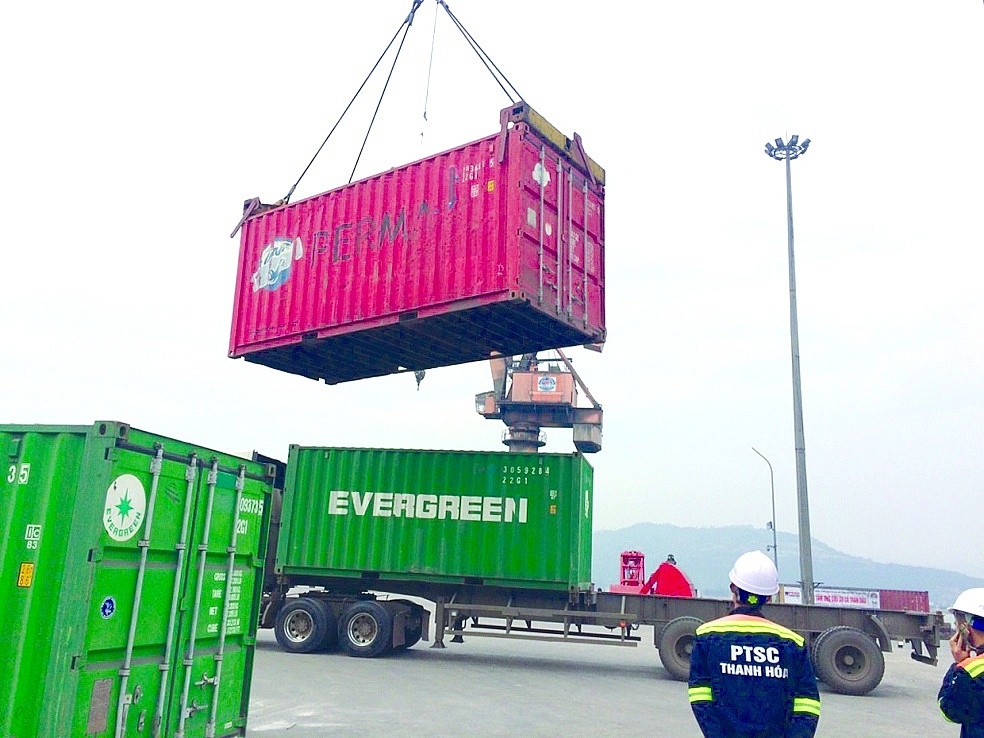Taking advantage of the large potential of the CPTPP market
Vietnamese enterprises can take advantage of the Comprehensive and Progressive Agreement for Trans-Pacific Partnership (CPTPP) and strategic gateways such as Canada, Mexico, Chile, and Peru to expand exports.
 |
|
Import and export activities at Nghi Son Seaport (Thanh Hoa). |
Textile and garment industry takes advantage of opportunities from CPTPP
According to statistics from the General Department of Customs, the total import and export turnover between Vietnam and CPTPP countries in the Americas recorded an impressive growth of 56.3% in the period 2018-2023. Specifically, from 8.7 billion USD in 2018, the import and export turnover reached 13.6 billion USD in 2023, although the world in this period faced many challenges such as economic recession and the Covid-19 pandemic. Notably, Vietnam's export turnover to this region nearly doubled, from 6.3 billion USD to 11.7 billion USD in the same period. At the same time, the trade surplus to these markets also increased sharply, from 3.9 billion USD to 11.01 billion USD, contributing positively to Vietnam's macroeconomic stability.
This result not only contributes to the growth of trade with CPTPP countries but also significantly contributes to the total trade between Vietnam and the entire Americas region, with a total import-export turnover of 137.7 billion USD in 2023, of which Vietnam exports 114.5 billion USD.
The CPTPP agreement opens up opportunities for many industries, especially the textile and garment industry - one of Vietnam's key industries. Mr. Vu Duc Giang, Chairman of the Vietnam Textile and Apparel Association, affirmed that the CPTPP is an FTA that creates great opportunities for the Vietnamese textile and garment industry to access markets such as Canada, Australia and New Zealand - markets that Vietnam previously had difficulty penetrating deeply.
The agreement not only helps businesses access the market but also creates conditions for textile and garment enterprises to adapt to the purchasing processes of import partners in the CPTPP bloc. In particular, the CPTPP's requirements for certificates of origin have encouraged businesses to improve product quality, from input materials to production, creating a competitive advantage over competitors in the global market.
“In 2023, the Vietnamese textile and garment industry recorded a total export turnover of 40 billion USD, of which CPTPP markets contributed 16% of the industry's total export turnover. In the first 9 months of 2024 alone, textile and garment export turnover reached 38.4 billion USD. Although Vietnam exports to 104 different markets around the world, the key markets are still the US (accounting for 39-40%), the EU, Japan, China and the CPTPP bloc. These figures show the success of the textile and garment industry in taking advantage of CPTPP in recent times,” Mr. Vu Duc Giang emphasized.
It is expected that in 2024, the Vietnamese textile and garment industry will continue to achieve an export turnover of 43-44 billion USD. However, to fully exploit the tariff incentives from CPTPP, enterprises need to increase investment in technology, optimize production and supply processes, and aim to participate more deeply in the value chain through original brand manufacturing (OBM) or original design manufacturing (ODM) models. These are considered key factors to enhance the competitiveness of Vietnamese textile and garment enterprises in the international market.
There is room and challenges for development
Despite great strides, trade between Vietnam and the American countries in the CPTPP bloc still faces many challenges. The total import-export turnover between Vietnam and the three markets of Canada, Mexico, and Peru in the CPTPP are only accounts for about 2% of Vietnam's total import-export turnover. In addition, the growth rate of trade with this group of countries is still unstable, with the trade proportion accounting for only 1.2% in 2019, increasing to 2% in 2021 but decreasing to 1.7% in 2023.
Notably, the market share of some of Vietnam's key export items in major markets such as Canada is showing signs of decline. For example, Vietnam's seafood market share in Canada has decreased from 6.4% in 2019 to 5.6% in 2023. This poses a big challenge for Vietnamese enterprises in maintaining and expanding market share in CPTPP countries.
Mr. Ngo Chung Khanh, Deputy Director of the Department of Multilateral Trade Policy (Ministry of Industry and Trade), said that CPTPP members are conducting a comprehensive review of the implementation process of the agreement to find new cooperation spaces. Although CPTPP has brought many opportunities, the room for trade development between Vietnam and member countries is still very large. With the UK joining CPTPP and many other economies applying to join, cooperation opportunities within the framework of this agreement will increasingly expand.
Mr. Khanh also emphasized that Vietnamese enterprises need to clearly grasp the benefits and ways to take advantage of CPTPP. The long geographical distance between Vietnam and the Americas is a major barrier in terms of transportation costs, so there needs to be a mechanism for in-depth cooperation and closer connections between businesses on both sides. At the same time, building business connections in the ecosystem that takes advantage of FTAs, expanding bilateral cooperation forms such as Vietnam-Canada, Vietnam-Mexico, and Vietnam-Peru is necessary to promote more effective cooperation in the future.
The CPTPP has been opening up many great opportunities for Vietnamese businesses, especially in expanding exports to the Americas. However, to fully exploit the potential of this agreement, businesses need to proactively seize opportunities, invest in technology, optimize production processes, and seek cooperation opportunities with partners in the CPTPP bloc.








